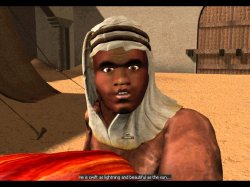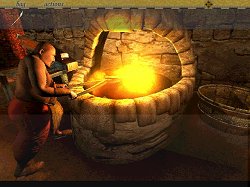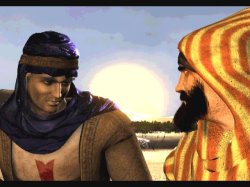|
The Legend of the Prophet and the Assassin
 This is only partially a sequel to Arxel Tribe's Pilgrim: Faith as a Weapon as it takes place in 1249, some forty years after the events of that game and the setting moves from the Languedoc region of France to the Middle East. Still the presence of Simon (your character in the first game) looms large in The Legend of the Prophet and the Assassin though he fails to make an appearance by the end of the game. It could easily have been subtitled The Search for Simon. I should note here that the search is incomplete and the game ends abruptly with a 'To be continued' message so be warned, if you want to know how the story ends you will have to purchase the sequel, The Secrets of Alamût. This is only partially a sequel to Arxel Tribe's Pilgrim: Faith as a Weapon as it takes place in 1249, some forty years after the events of that game and the setting moves from the Languedoc region of France to the Middle East. Still the presence of Simon (your character in the first game) looms large in The Legend of the Prophet and the Assassin though he fails to make an appearance by the end of the game. It could easily have been subtitled The Search for Simon. I should note here that the search is incomplete and the game ends abruptly with a 'To be continued' message so be warned, if you want to know how the story ends you will have to purchase the sequel, The Secrets of Alamût.
The introduction is dramatic, but not overly informative so to learn something of the background of your character you must read the brief overview in the manual. Born of noble parentage in the Languedoc, Tancrède de Nerac was a wilful and belligerent child. He was wounded and captured during the Fifth Crusade and eventually rescued by the Templars. He joined their cause but soon, tired of petty skirmishes, he and a companion, Caradoc d' Orse, deserted in favour of a life of pillage and massacre. Tancrède became the feared bandit, As-Sayf (the Scimitar). After many years of this nomadic outlaw existence and with a troubled conscience he learned about a prophet named Simon de Lancrois and about a city he was building called Jebus. As-Sayf leaves Caradoc to find this city and, perhaps, absolution.
The game deposits As-Sayf (and you) in front of the gates of Jebus where you learn of Simon's betrayal of his followers so you resolve to track him down and kill him. (Don't forget this was the Thirteenth Century and violence was still the way to solve most problems just as it is today.) Given As-Sayf's violent background you will need to kill two other characters who get in your way, though this isn't an action/adventure by any means and the combat, such as it is, generally relies on you selecting your sword and clicking it once on your adversary. Once you know what you have to do there is sufficient time to carry out the action. You will die a lot in other parts of the game, however, so you need to watch your step and save often.
 The first section where you must explore the town and learn what has happened is quite interesting, but later parts of the game tend to be much more story driven and jerk you from one small section to the next on completion of just a short sequence of tasks.
The demands of the story and the brief episodic nature of the tasks frequently left me with the feeling that I had been led by the nose and that, although I was doing things I wasn't always immediately aware of the reasons why. For example, during a conversation with another character about rescuing an Astrologer, As-Sayf says he has a better plan and suddenly you are whisked away to an earlier location at night time. As-Sayf may have had a plan but he didn't let me in on it. In this case it wasn't too difficult to work out what you needed to do as essentially you just use things you find in one small location and the plan becomes obvious. However, this is what I mean when I say 'led by the nose', it is the game that takes the initiative rather than the player. This game design also seemed to dictate one location, one task and I much prefer to have a range of problems to think about and overcome.
Having said that, there was some variety to the puzzles and the game was entertaining enough to keep me playing. At one point I was stuck because I failed to combine two items in my inventory. I still can't believe I missed that. At another time I filled my inventory with numerous items most of which were clever red herrings so the game is not without a sense of fun. Those of you who have played Pilgrim may remember running errands and solving problems for a group of merchants; well there is a similar sequence in this game though it is nowhere near as complex or involving. Other tasks include piecing together an iron Golem and, one that was particularly interesting, interpreting an astrological puzzle. The first section where you must explore the town and learn what has happened is quite interesting, but later parts of the game tend to be much more story driven and jerk you from one small section to the next on completion of just a short sequence of tasks.
The demands of the story and the brief episodic nature of the tasks frequently left me with the feeling that I had been led by the nose and that, although I was doing things I wasn't always immediately aware of the reasons why. For example, during a conversation with another character about rescuing an Astrologer, As-Sayf says he has a better plan and suddenly you are whisked away to an earlier location at night time. As-Sayf may have had a plan but he didn't let me in on it. In this case it wasn't too difficult to work out what you needed to do as essentially you just use things you find in one small location and the plan becomes obvious. However, this is what I mean when I say 'led by the nose', it is the game that takes the initiative rather than the player. This game design also seemed to dictate one location, one task and I much prefer to have a range of problems to think about and overcome.
Having said that, there was some variety to the puzzles and the game was entertaining enough to keep me playing. At one point I was stuck because I failed to combine two items in my inventory. I still can't believe I missed that. At another time I filled my inventory with numerous items most of which were clever red herrings so the game is not without a sense of fun. Those of you who have played Pilgrim may remember running errands and solving problems for a group of merchants; well there is a similar sequence in this game though it is nowhere near as complex or involving. Other tasks include piecing together an iron Golem and, one that was particularly interesting, interpreting an astrological puzzle.
 Visually, The Legend of the Prophet and the Assassin is spectacular. It is played from a first-person perspective interspersed with some stunning third-person cut sequences. The music certainly adds to the atmosphere and the voice of As-Sayf is provided by Geoffrey Bateman whom many will remember from his role as the voice of Mephistopheles in Arxel Tribe's Faust.
The game is a mouse-controlled adventure that is played in full screen and allows for 360 degree panning. A click of the right mouse button brings up a resource bar at the top of the screen where you can access your inventory and game controls and a separate menu for actions. Your weapons are held here but they are rarely used for fighting. The shield is strangely used to select dialogue themes when you talk to other characters. It is great that one of the game options allows you to select subtitles, and all inventory items are conveniently named. I appreciated both of these aspects although it would have been even better if potential inventory items could have been identified before picking them up.
The story is quite interesting as far as it goes but there isn't that sense of resolution or completion so, to be fair, it really does need to be labelled as part one of a two part series. Many players may wish to wait until they have both games before commencing this journey. Visually, The Legend of the Prophet and the Assassin is spectacular. It is played from a first-person perspective interspersed with some stunning third-person cut sequences. The music certainly adds to the atmosphere and the voice of As-Sayf is provided by Geoffrey Bateman whom many will remember from his role as the voice of Mephistopheles in Arxel Tribe's Faust.
The game is a mouse-controlled adventure that is played in full screen and allows for 360 degree panning. A click of the right mouse button brings up a resource bar at the top of the screen where you can access your inventory and game controls and a separate menu for actions. Your weapons are held here but they are rarely used for fighting. The shield is strangely used to select dialogue themes when you talk to other characters. It is great that one of the game options allows you to select subtitles, and all inventory items are conveniently named. I appreciated both of these aspects although it would have been even better if potential inventory items could have been identified before picking them up.
The story is quite interesting as far as it goes but there isn't that sense of resolution or completion so, to be fair, it really does need to be labelled as part one of a two part series. Many players may wish to wait until they have both games before commencing this journey.
Copyright © Gordon Aplin 2001.
All rights reserved.
System Requirements:
Win 95/98/2000, P200 MMX, 32MB RAM, 290 MB free hard disk space, mouse, SoundBlaster compatible soundcard, 16-bit color graphics (24-bit recommended), 2MB video memory.
|

